Belize Aggressor IV, BelizeContents of this Issue: Be Concerned About the Guy Across the Aisle South Caicos, Jupiter, St. Vincent, Cozumel Your Reader Reports Have Never Been More Important Guidelines for Divers to Avoid Spreading Coral Disease Did COVID-19 Cost You Money in Lost Reservations? Galapagos Migratory Sharks Threatened by Giant Chinese Fishing Fleet Wearing Fins on Deck Proves Fatal Put Your Fins On Last and Avoid Taking a Tumble Why Does Your Regulator Free-flow? Coast Guard Sued by 34 Families Editorial Office: Ben Davison Publisher and Editor Undercurrent 3020 Bridgeway, Suite 102 Sausalito, CA 94965 Easy concierge diving, with sharks galore from the October, 2021 issue of Undercurrent
I'm not a morning person but at 5:54 a.m. I was awake. After all, it's was a dive day! My large cabin window on the Belize Aggressor IV looked out on a calm sea and fluffy clouds in early-morning hues of blue-grays and whites. A morning Diet Coke had been delivered to my door for me, and there was steaming hot coffee for my assigned roommate. And then off to a Continental breakfast, a dive, then a full breakfast.
A few weeks before the trip began, the coronavirus Delta variant had reached the U.S., and I seriously considered canceling. The Aggressor folks thought they could resell my cabin and offer me a different date. However, I soon decided I'd overreacted and even booked a second consecutive week! And am I glad I did. I made 20 dives in September's 86º water the first week, with my favorites at Tarpon Cave. On the first, after a swim over turtle grass at 45 feet, we headed along the wall. At 75-feet, friendly four to five-foot blacktip reef sharks mingled with the divers, and eagle rays came by at close range. I spotted a pair of French angels to shoot but got photobombed by a prima donna Nassau grouper, which took off as I adjusted to take his photo. Horse-eye jacks spun like a tornado and stuck around with some divers for the entire dive. As I surveyed the shallow part of the reef, approximately 80% of common sea fans seemed to have damage. The health of the corals and sponges seemed to be better on the walls than in the shallows. There were plenty of barrel sponges, tube sponges, and strawberry and azure vase sponges. Yellow crinoids peeked out from ledges along with club tip anemones and pretty branching anemones. I saw a variety of corals, including cactus, brain, leaf, sheet, boulder, black, and cup coral. On our second dive here, blacktip reef sharks checked out every diver so many times that getting a good photo was as easy as hitting a barn door with a bass fiddle. As I was making my safety stop, I looked down to see two sharks circling ever tighter around one diver carrying a GoPro on a fully extended stick. Oddly, each shark chomped on it, ripping off her light and dome and yanking a red filter off her housing. No panic there. She casually descended to retrieve the dome and light. Speculation was that the sharks perceived the GoPro as a lionfish on the end of a spear. I flew in early and stayed at the Radisson Ft. George, where the Aggressor moored on the dock right out front. When I boarded the next day at 3 p.m., the crew had already retrieved my luggage and arranged it in my cabin, which had two single beds (not bunks), a bathroom, under-bed storage for suitcases, a bedside table with two drawers, and a closet. I noticed water damage and black mold on the ceiling tiles (it was in other cabins as well) -- not an uncommon tropical scourge, but a bit unnerving. Without floor mats to absorb puddles from wet bathing suits, I used one of the waffle-fabric Aggressor robes to mop up water. Ninety minutes after boarding, Captain Dennis Gautreau, a fun, communicative guy, briefed us divers (17 divers and two snorkelers, including Canadians and two Brits). Dennis introduced the crew, including our dedicated night watchman, Zander. He would make rounds every 20 minutes throughout the night; at midnight, he would unplug all equipment on the dive deck, then plug it back in at 5 a.m., a safety measure apparently installed after the Conception tragedy. (No camera equipment was to be charged in cabins; laptops or phones were to be unplugged when we left our cabins.) It was a thorough PowerPoint briefing, leaving me with only one question: where were microwave and popcorn located? The following morning, we received a detailed dive briefing before we hit the water.
The Aggressor has two camera tables with compressed air to dry off cameras, ample shelving for rechargeable gear, and many outlets. Since many divers had compact cameras, I shared a table with Roque, our video pro. Each diver chose a station where their tank was kept; each had a basket to store their bits and bobs under the bench. Fins were kept on the dive platform -- no fin-walking across the deck while geared up -- and after the dive, the crew helped remove everyone's fins in the water. On the first day, winds up to 30 knots produced murky, pea-soup-green water, and forced the boat to make wide swings on its mooring. While a T-bar (with a spare regulator) hung at 15 feet, they advised us to take our safety stops in midwater that day unless we wanted to take a wild ride since it might take up to three minutes for the boat to swing away and return. But at 15 feet, the current pushed me in a longer radius, so when the boat came back, I needed to grab a rope connected to a chase boat. For the remainder of two day's dives, I either grabbed the bar or off-gassed midwater, depending on the boat's movement.
All but one stateroom are on the dive deck level; the remaining (large) stateroom is on the lower deck alongside crew quarters. A restaurant, open-air lounge, and the helm are on the lido deck. The top deck, a sun deck, has a drink station with soft drinks, kegs of complimentary local beer, and bar seating. Stewardess Elia Daniels remembered passengers' preferences on drinks, delivered beverages to our room each morning, and minded our rooms twice daily. She was pleasant at every turn. Overall, I had two shark-tastic weeks, with plenty of Caribbean reef sharks and nurse sharks to go with the blacktips.(This trip would be tremendous for newbies who want to see sharks.) Most afternoons, a couple of dozen huge tarpon showed up for our late afternoon dives and stuck around to hunt for food with the aid of our lights during night dives. I spotted beautiful blue indigo hamlets on every dive. Once, my buddy showed me a tiny eel, his head only a centimeter wide! I saw plenty of neck crabs, green morays, spotted drums in all development phases, and gray, French, and queen angels. Occasionally, queen triggers drifted by.
I brought a new Nikon z6ii and a new Isotta housing on this trip and had a problem with the housing flash trigger mechanism. Roque came up with a workaround that allowed me to take some photos. At the end of the trip, when we returned to the dock and acquired internet access, I arranged a video call with the owners of Isotta directly from Italy! They guided me through changing the housing's factory settings to solve the problem. Having dived Belize's famous Blue Hole a couple of times -- it's a one-time thrill to drop to 130 feet in dim light to swim through large stalactite caverns -- I decided this time to stay in the shallows, about 20 feet deep, enjoying the ambient light on the reefs. With three other divers, I meandered among abundant fans, spotted a small blacktip reef shark, blue parrotfish, a beautiful (and sizeable) midnight parrotfish, and an abundance of the usual reef fish, and found a freckled sea hare. (I wished we could have done a second dive here with a guide helping us spot the teeny tiny stuff.) The snorkelers got up close and personal with a blacktip. I was disappointed that the dive staff didn't put more effort into pointing out critters during our dives. If there were a single highlight on a dive site -- seahorse, mantis shrimp, snapping shrimp -- the guide showed every diver. Other than that, I would have had to follow Roque and peek at what he was filming. As a paying guest, I think a dive crew is there to point out critters and help guests get shots rather than spend most of a dive doing their own photography. On a night dive with Roque as my buddy, he neither checked in on me nor pointed out critters, but instead, flitted from here to there randomly and rapidly. As the Aggressor "video pro," he was immersed in his own work. While it's "against my religion" to end a dive with time left on the clock, I gave up at 48 minutes, anticipating the hot chocolate spiked with Belizean Craboo Cream liquor the crew always had waiting for me.
During many of my past Caribbean night dives, bloodworms ("gnats of the sea") chaotically swarmed around lights and bounced off divers. On this trip, there were few, so I entertained myself by bringing my light to corals, which would then eat the swarming bloodworms. "Sorry, not sorry," bloodworms! On a couple of night dives, I spotted an octopus. Slowly approaching, I would tap my fingers on the sand or the rubble in front of it, and it would often wrap its arms around my fingers. I had my own personal Octopus Teacher (see the film, if you haven't.) At Long Caye Wall, Simon pointed out a swim-thru running from 50- to 90 feet that was full of silversides, a thrilling experience. However, I was disappointed on another dive when Simon took off with half the group to find a white-spotted toadfish. It was only at the end of the dive that he took my buddy and me to the hidden toadfish, but he was too low on air to hang around, and I only caught a glimpse of its tail. Oh well. But, my complaints are minor. The first week, I made 20 of the 24 dives offered, thanks to the helpful staff. The second week I became an "Iron Diver," completing all 24 dives offered. Without the staff's significant help in hauling around my gear and camera, I would not have been able to do all the dives I did. That assistance was far more important than having them show me critters or even accommodate my dive objectives. So, on the whole, I'm "thumbs up" on the entire staff. It was a great two weeks. -- -- E.T.S. Our undercover author's diving obsession was sparked at age eight when her parents got a fresh water fish tank. She became a D.M. after diving for 17 years, and has talked her adult daughter into diving and convinced her husband to carry her gear. She's a plus-sized woman who believes diving can be done by people of all ages and sizes, and even those with no athletic prowess whatsoever - making it the perfect sport for her. She reached her 500th dive during this trip, and has been spending her daughter's inheritance while spreading her dive travel fairly equally among the Hawaiian Islands, the Caribbean, and Indonesia.
|

I want to get all the stories! Tell me how I can become an Undercurrent Online Member and get online access to all the articles of Undercurrent as well as thousands of first hand reports on dive operations world-wide
| Home | Online Members Area | My Account |
Login
|
Join
|
| Travel Index |
Dive Resort & Liveaboard Reviews
|
Featured Reports
|
Recent
Issues
|
Back Issues
|
|
Dive Gear
Index
|
Health/Safety Index
|
Environment & Misc.
Index
|
Seasonal Planner
|
Blogs
|
Free Articles
|
Book Picks
|
News
|
|
Special Offers
|
RSS
|
FAQ
|
About Us
|
Contact Us
|
Links
|
3020 Bridgeway, Ste 102, Sausalito, Ca 94965
All rights reserved.

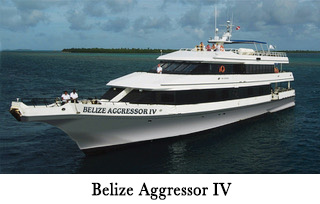 I arrived as a single diver, and during our checkout dive, I found myself diving with an experienced group. During the week, everyone's situational awareness was outstanding. There were few buoyancy incidents, no drama around sharing photographic subjects, and I got bumped only a few times during night dives. Most divers went at a leisurely pace and chose to stick between 50 and 80 feet. (The Aggressor crew asked that we keep most dives under 100 feet.) Best of all, my roommate turned out to be an excellent buddy, and we asked another single diver to join us.
I arrived as a single diver, and during our checkout dive, I found myself diving with an experienced group. During the week, everyone's situational awareness was outstanding. There were few buoyancy incidents, no drama around sharing photographic subjects, and I got bumped only a few times during night dives. Most divers went at a leisurely pace and chose to stick between 50 and 80 feet. (The Aggressor crew asked that we keep most dives under 100 feet.) Best of all, my roommate turned out to be an excellent buddy, and we asked another single diver to join us.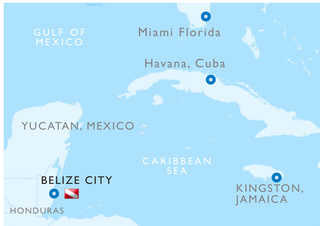 With five dives most days, we were to limit our dives to 60 minutes (including the safety stop) and be back on the boat with 500 psi. Because of two back injuries and a bum knee, I asked instructor Roque Queme, who hailed from Belize City, if I could don my gear at the dive platform and doff it in the water. Not a problem, and he reviewed the process for a seated entry. Once in the water, the crew handed me my camera. After the dive, I handed it up, and they rinsed it before returning it to the camera table. (I ensured their good service was reflected in my tip.)
With five dives most days, we were to limit our dives to 60 minutes (including the safety stop) and be back on the boat with 500 psi. Because of two back injuries and a bum knee, I asked instructor Roque Queme, who hailed from Belize City, if I could don my gear at the dive platform and doff it in the water. Not a problem, and he reviewed the process for a seated entry. Once in the water, the crew handed me my camera. After the dive, I handed it up, and they rinsed it before returning it to the camera table. (I ensured their good service was reflected in my tip.)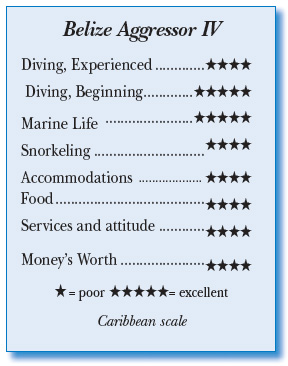 That first "rodeo" used a lot of energy, so I looked forward to the generally excellent meals (aside from lackluster turkey sandwiches one day for lunch). Chef Jerry Lee Camano and Sous Chef Carlos Soler prepared chicken that was so fork-tender I thought it might be fish. Daily, we were served delicious soups for lunch, including a lentil soup so good that people who didn't like lentil soup changed their minds. A lunch of shrimp curry fell short because the shrimp quality didn't measure up to other shrimp meals. Fish in a banana salsa was excellent. "Cheeseburgers in Paradise" and "Reef and Beef" (shrimp and steak) were perfectly cooked. I did a happy dance for Jerry on the day macaroni and cheese was served! A popular local Banoffee pie was made from a blend of toffee, banana, and coffee cream, and I brought the recipe home for Jerry's plum cake. The complimentary house red and house white wines were also quite good.
That first "rodeo" used a lot of energy, so I looked forward to the generally excellent meals (aside from lackluster turkey sandwiches one day for lunch). Chef Jerry Lee Camano and Sous Chef Carlos Soler prepared chicken that was so fork-tender I thought it might be fish. Daily, we were served delicious soups for lunch, including a lentil soup so good that people who didn't like lentil soup changed their minds. A lunch of shrimp curry fell short because the shrimp quality didn't measure up to other shrimp meals. Fish in a banana salsa was excellent. "Cheeseburgers in Paradise" and "Reef and Beef" (shrimp and steak) were perfectly cooked. I did a happy dance for Jerry on the day macaroni and cheese was served! A popular local Banoffee pie was made from a blend of toffee, banana, and coffee cream, and I brought the recipe home for Jerry's plum cake. The complimentary house red and house white wines were also quite good.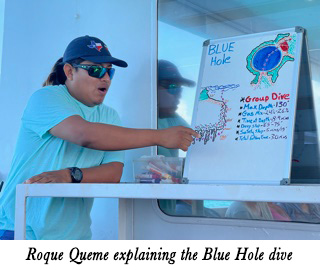 The Elbow is one of Belize's premier drift dives. The first week I asked Captain Dennis if we could dive it -- nope -- and the second week asked Captain Shea Markwell, who said he'd never done the dive from the IV. Later, the first mate told me the 128-foot Aggressor IV was too big to make that dive. Aggressor H.Q.: please take it off your dive list instead of ginning up expectations.
The Elbow is one of Belize's premier drift dives. The first week I asked Captain Dennis if we could dive it -- nope -- and the second week asked Captain Shea Markwell, who said he'd never done the dive from the IV. Later, the first mate told me the 128-foot Aggressor IV was too big to make that dive. Aggressor H.Q.: please take it off your dive list instead of ginning up expectations.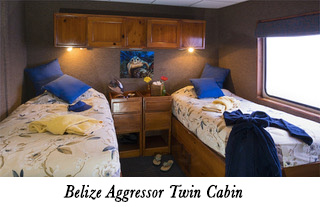 I enjoyed diving with divemaster John, a calm, playful person with a deep knowledge of fish. He went at my snail's pace, kept an eye on us, and checked in to show me such things as a two-inch lettuce leaf sea slug and a stunning wall of corallimorphs. He even modeled in photos. Before one dive, I asked if he would point out Belize's painted tunicates, and he immediately showed them to me after descending.
I enjoyed diving with divemaster John, a calm, playful person with a deep knowledge of fish. He went at my snail's pace, kept an eye on us, and checked in to show me such things as a two-inch lettuce leaf sea slug and a stunning wall of corallimorphs. He even modeled in photos. Before one dive, I asked if he would point out Belize's painted tunicates, and he immediately showed them to me after descending. Divers Compass: Seven-night cruises run $3200-$3400/person, double occupancy; a couple of months before departure deals may show up (
Divers Compass: Seven-night cruises run $3200-$3400/person, double occupancy; a couple of months before departure deals may show up (